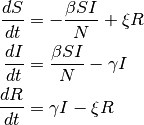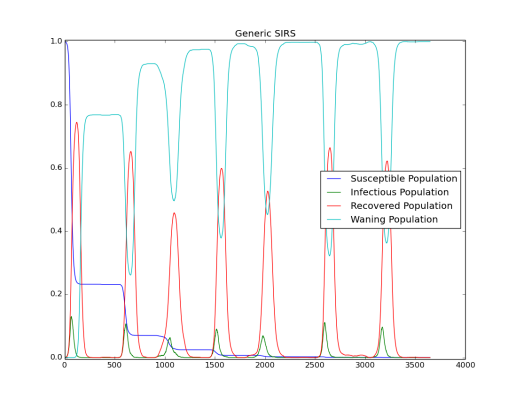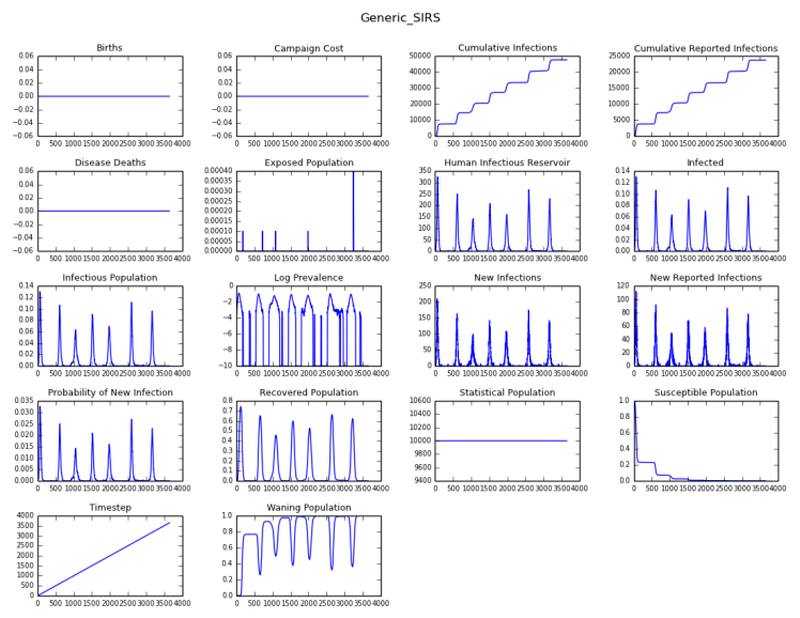Generic 5: SIRS - Waning immunity¶
This tutorial assumes that you have read Generic 4: SEIR - Vital dynamics (birth and death).
The SIR model assumes people carry lifelong immunity to a disease upon recovery; and this is the
case for a variety of diseases. For another class of airborne diseases, for example seasonal
influenza, an individual’s immunity may wane over time. In this case, the SIRS model is used allow
recovered individuals return to a susceptible state. Specifically,  is the rate which recovered
individuals return to the susceptible statue due to loss of immunity. If there is sufficient influx
to the susceptible population, at equilibrium the dynamics will be in an endemic state with damped
oscillation.
is the rate which recovered
individuals return to the susceptible statue due to loss of immunity. If there is sufficient influx
to the susceptible population, at equilibrium the dynamics will be in an endemic state with damped
oscillation.

The EMOD executable (Eradication.exe) simulates waning immunity by a delayed exponential distribution. Individuals stay immune for a certain period of time then immunity wanes following an exponential distribution. Because the shedding and acquisition process is separate, two kinds of immunity can be waned: transmission and acquisition immunity.
Demographic inputs¶
This tutorial uses generic_scenarios_demographics file for demographics input. You can view the demographics file at <path_to_directory>RegressionScenariosInputFiles where <path_to_directory> is the location where EMOD source files were installed. For more information on demographics files, see Demographics parameters.
Key configuration parameters¶
You can view the complete config.json in the ScenariosGeneric05_SIRS directory.
Population dynamics parameters¶
Set Enable_Vital_Dynamics to 0. This will disable vital dynamics (birth and death) in the simulation. For more information, see Population dynamics parameters.
SIRS model setup parameters¶
The model setup is similar to an SIR model. The immunity decay is enabled so that recovered individuals can return to susceptible at a later time. For more information, see Incubation and Immunity parameters.
Set the following parameters:
- Set Base_Incubation_Period to 0.
- Set Enable_Immunity to 1.
- Set Enable_Immune_Decay to 1.
- Set Incubation_Period_Distribution to “FIXED_DURATION.”
Disease parameters¶
In the following example, the average infection duration is 7 days, and R0 = 1.75 which is similar to influenza. For more information, see Infectivity and transmission parameters.
Set the following parameters:
- Set Base_Infectivity to 0.25.
- Set Base_Infectious_Period to 7.
- Set Infectious_Period_Distribution to “EXPONENTIAL_DURATION.”
Immunity parameters¶
There are three immunity factor parameters: Immunity_Acquisition_Factor, Immunity_Transmission_Factor, and Immunity_Mortality_Factor. At the time of recovery when the infection is cleared, the values of immunity against acquisition, transmission, and mortality are multiplied by
(1- the value of the corresponding immunity factor parameter).
For example, the multiplier for Acquisition_Blocking_Immunity_Decay_Rate is Immunity_Acquisition_Factor and the multiplicative reduction in the probability of reacquiring the disease is:
Acquisition_Blocking_Immunity_Decay_Rate x (1 - Immunity_Acquisition_Factor)
In this simulation, individual’s immunity decays with an average half-life of 180 days and a 90-day offset. This applies to both transmission blocking and acquisition blocking immunity. This tutorial does not use the Mortality_Blocking_Immunity_Decay_Rate, however, the next tutorial, Generic 6: SEIRS - Disease-specific mortality and endemics, does. For more information, see Immunity parameters.
Set the following parameters:
- Set Acquisition_Blocking_Immunity_Duration_Before_Decay to 90.
- Set Transmission_Blocking_Immunity_Duration_Before_Decay to 90.
- Set Acquisition_Blocking_Immunity_Decay_Rate to 0.0056.
- Set Transmission_Blocking_Immunity_Decay_Rate to 0.0056.
- Set Immunity_Acquisition_Factor to 0.
- Set Immunity_Mortality_Factor to 0.
- Set Immunity_Transmission_Factor to 0.
Simulation duration parameters¶
The simulation is run for 10 years with a 1-day time step. For more information, see Simulation setup parameters.
Set the following parameters:
- Set Simulation_Timestep to 1.
- Set Simulation_Duration to 3650.
Interventions¶
This simulation uses the campaign.json file in the ScenariosGeneric05_SIRS directory.
Outbreak with re-seeding¶
This simulation uses an OutbreakIndividual event for an infrequent infection seeding. The Timesteps_Between_Repetitions and Number_Repetitions parameters are set to reintroduce the outbreak once every 180 days for 10 years, to allow reintroduction of disease. For more information, see OutbreakIndividual parameters.
{
"Event_Coordinator_Config": {
"Intervention_Config": {
"Antigen": 0,
"Genome": 0,
"Outbreak_Source": "PrevalenceIncrease",
"class": "OutbreakIndividual"
},
"Target_Demographic": "Everyone",
"Demographic_Coverage": 0.0005,
"Number_Repetitions": 20,
"Timesteps_Between_Repetitions": 180,
"class": "StandardInterventionDistributionEventCoordinator"
},
"Event_Name": "Outbreak",
"Nodeset_Config": {
"class": "NodeSetAll"
},
"Start_Day": 1,
"class": "CampaignEvent"
}
Run the simulation¶
Run the simulation and generate graphs of the simulation output. For more information, see Run simulations.
Note
Because the EMOD model is stochastic, your graphs may appear slightly different from those given below.
Simulation output graphs¶
Figure 1 shows damped oscillation due to people losing immunity and becoming susceptible again.
Note
Individuals who are susceptible people due to waning immunity are not classified as susceptible in the simulation. They are reported under the “Wane Population” channel.

Figure 1: Simulation output - damped oscillation

Figure 2: Simulation output - all channels
Exploring the model¶
Change the waning immunity distribution by modifying the number of days until immunity starts to decay and the immunity decay rate. For example, to represent a step-like function:
- Set the Acquisition_Blocking_Immunity_Duration_Before_Decay and Transmission_Blocking_Immunity_Duration_Before_Decay to 180.
- Set Acquisition_Blocking_Immunity_Duration_Before_Decay and Transmission_Blocking_Immunity_Duration_Before_Decay to 1.